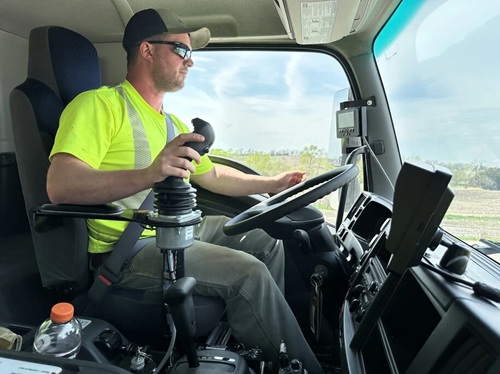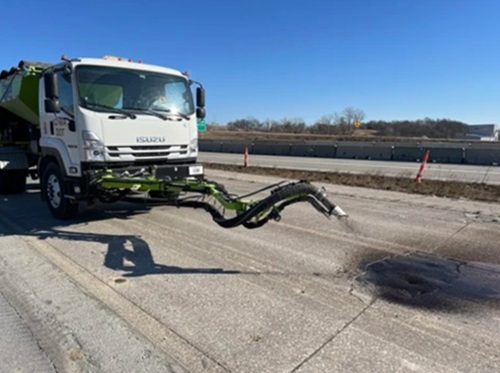Earlier this year, the Iowa Department of Transportation purchased the state’s first self-contained pothole filling truck – a more efficient and safer option for fixing potholes on state roadways.
[Above photo by Iowa DOT]
Operated by a single individual, the “Cimline Durapatcher” – currently deployed in Iowa DOT’s District 4, based in Council Bluffs, and in District 1, based in Ames – this self-contained vehicle mixes and applies emulsion in a fraction of the time with a fraction of the labor.
More importantly, it is safer than the current pothole-filling method, which requires a dump truck and a trailer-mounted hopper to be followed by two or three staff to spread the material with shovels and compaction tools by hand – all while exposed to traffic.
[Editor’s note: The video below by the Idaho Department of Transportation illustrates some of the dangers traditional pothole filling crews face when working on busy roadways.]
After a tragic I-80 work zone crash that killed Matt Dickerson, an Iowa DOT District 4 staff member, near Council Bluffs in 2024, the agency’s field staff and leadership have sought out safer ways to accomplish routine work like pothole patching.
“The ability to remove staff from the operation takes more employees off the road … to do different tasks for the day. It also increases safety by putting one operator in a protected truck cab that protects them,” said Cory Kirkpatrick, maintenance supervisor for Iowa DOT’s DeSoto/Perry garage, in a blog post. “With no staff on the roadway and faster filling, this truck also reduces the disruption to the public, so we’re able to provide a higher level of service to our customers.”

The agency said the Cimline Durapatcher pothole patching machine preps and installs a patch in minutes without the need for compaction. The truck chassis houses a hopper to hold the supply of rock chips and a 300-gallon heated oil tank that together produce enough product to apply approximately 10 tons of patch material.
Inside the cab, the operator uses a joystick to control mixing and pump the oil – known as emulsion – and rock material forward to a hydraulic arm and nozzle in the front of the unit. When the Durapatcher approaches a pothole, the operator can activate a compressor to clear debris and water.
The next step is to spray the emulsion to fully coat the inside of the pothole, followed by the application of a rock and emulsion mixture. “We’re looking for a salt and pepper look with the black emulsion oil and the light-colored rock,” noted Matt Conaway with the DeSoto Maintenance garage. “Then we’re adding another layer of clean rock over the top to protect the public’s vehicles from the oil.”
As Iowa DOT’s maintenance shops continue to learn more about operating the new system, the agency said reviews of the new pothole filling machine are positive as staff find the new technology to be more streamlined than the conventional dump truck and trailer method.
Iowa DOT added that staff report that the system is “instinctive” to new operators and allows them to get closer to the pothole to see where levelling is needed to provide a better seal and more comfortable ride for the public.
 States
States
Washington D.C. Launches E-Bike Food Delivery Pilot
July 18, 2025 States
States

